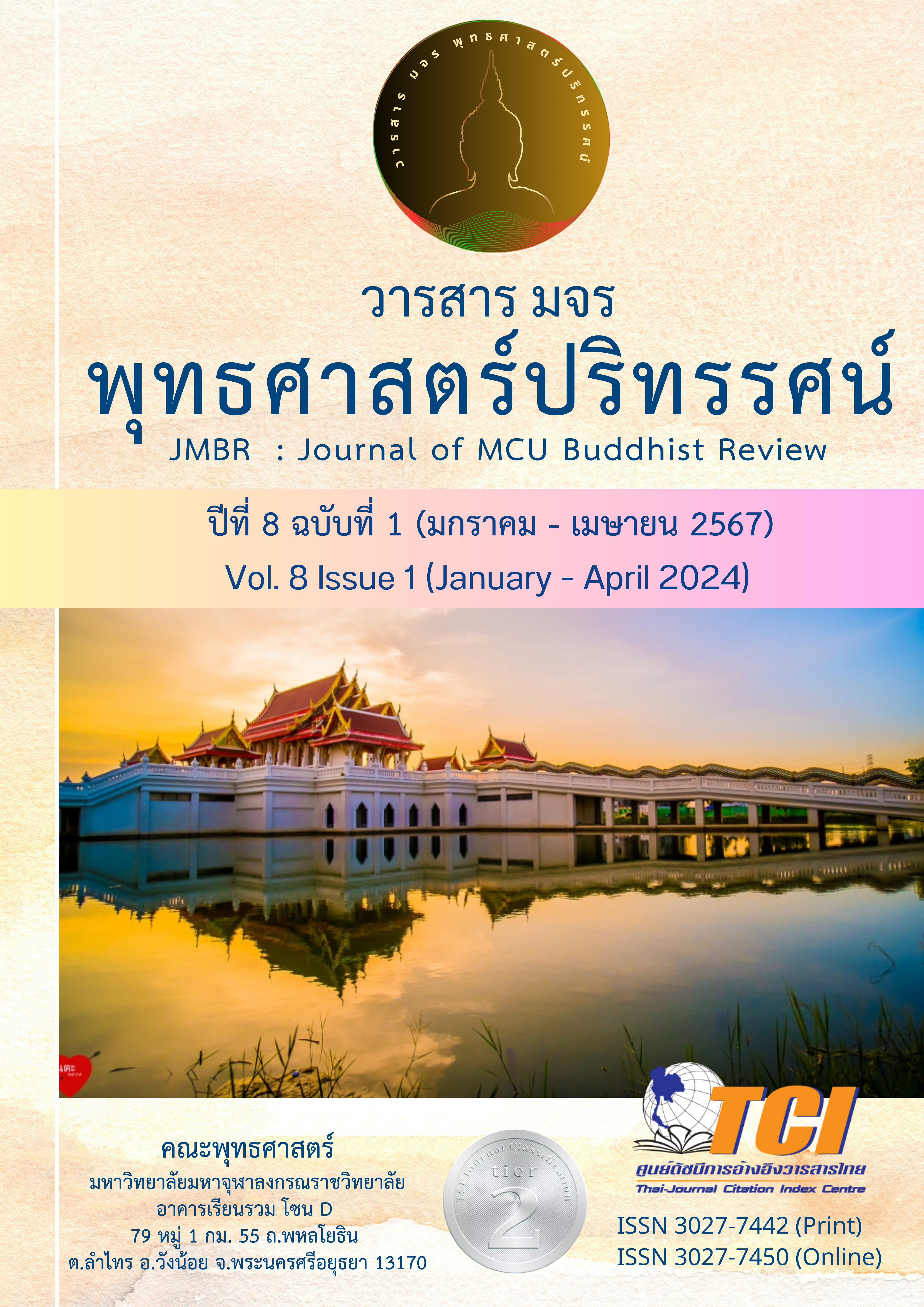ความงาม : สาระสำคัญที่คนธรรมดามองไม่เห็น
Main Article Content
บทคัดย่อ
บทความวิชาการว่าด้วยความงาม เป็นการกำหนดความรู้สึกจากการรับรู้สู่จิตใจตามความต้องการและรสนิยมของคนส่วนใหญ่ในสังคมนั้นๆ ความงามแต่ละยุคแต่ละสมัยมีความแตกต่างกันขึ้นอยู่กับสภาพสังคม วัฒนธรรม ศาสนา สภาวะจิตใจ อารมณ์ และความศรัทธา โดยมนุษย์สามารถรับรู้คุณค่าของความงามได้จากภายในตัวของวัตถุ จากจิตที่กำหนดและจากสภาวะความสัมพันธ์ของวัตถุและจิตใจ ในทางพุทธศาสนาจำแนกความงามออกเป็น 2 ประเภท คือ ความงามในมิติทางโลกและความงามในมิติทางธรรม ซึ่งความงามในมิติทางโลก เป็นประสบการณ์ความงามทางวัตถุที่เกิดจากการปรุงแต่งจิตใจ ตัวอย่างความงามในมิติทางโลกที่ปรากฎในพระไตรปิฎก เช่น ความงามของลักษณะมหาบุรุษ 32 ประการ สตรีผู้มีลักษณะงามแบบเบญจกัลยาณี ฯลฯ ส่วนความงามในมิติทางธรรม หมายถึง ความงามที่เป็นลักษณะของธรรมหรือความจริงอันเป็นผลจากคุณสมบัติของธรรมที่ปรากฏต่อการรับรู้ของมนุษย์ ความงามของธรรมจึงเป็นสากล ทุกคนที่รู้หรือสัมผัสย่อมรู้ได้หรือสัมผัสได้ตรงกันเหมือนกัน นอกจากนี้พระพุทธเจ้ายังสอนผู้ที่หลงใหลยึดติดในความงามให้พิจารณาความไม่งาม (อสุภะ) โดยการมองให้เห็นความไม่เที่ยงของร่างกาย จิตใจก็จะไม่ยึดติดกับรูปที่เห็น เสียงที่ได้ยิน กลิ่นที่ได้ดม รสที่ได้ลิ้ม กายที่ได้สัมผัส ปล่อยวางในเรื่องของรูปนาม ปฏิบัติถูกต้องตามพระดํารัสของพระสัมมาสัมพุทธเจ้า สามารถดับกิเลสและกองทุกข์ได้โดยสิ้นเชิง ความงามความบริสุทธิ์ของจิตก็จักเกิดขึ้น
Article Details

อนุญาตภายใต้เงื่อนไข Creative Commons Attribution-NonCommercial-NoDerivatives 4.0 International License.
- บทความที่ได้รับการตีพิมพ์เป็นลิขสิทธิ์ของวารสาร มจร พุทธศาสตร์ปริทรรศน์
- ข้อความใดๆ ที่ปรากฎในบทความที่ได้รับการตีพิมพ์ในวารสาร ถือเป็นความรับผิดชอบของผู้เขียนบทความ และข้อคิดเห็นนั้นไม่ถือว่าเป็นทัศนะและความรับผิดชอบของกองบรรณาธิการวารสาร มจร พุทธศาสตร์ปริทรรศน์
เอกสารอ้างอิง
กองวิชาการมหาวิทยาลัยธรรมกาย แคลิฟอร์เนีย. (2550). สูตรสำเร็จการพัฒนาตนเองตามหลักมงคลชีวิต. สืบค้น 20 มกราคม 2567 จาก https://cdn.fs.teachablecdn.com/Vlvi8uNZSB63KFEVEkrA
เขมจิต ศรีบุนนาค. (2542). สุนทรียภาพแห่งชีวิต. กรุงเทพฯ: การศึกษาคลื่นลูกที่สาม.
นฤพนธ์ ด้วงวิเศษ. ศูนย์มานุษยวิทยาสิรินธร. สืบค้น 20 มกราคม 2567 จาก https://www.sac. or.th/ portal/th/article/detail/377
พระพรหมคุณาภรณ์ (ป.อ.ปยุตฺโต). (2551). พจนานุกรมพุทธศาสน์ฉบับประมวลศัพท์. (พิมพ์ครั้งที่ 11). กรุงเทพฯ: เอส. อาร์. พริ้นติ้งแมส โปรดักส์.
พ่วง มีนอก. (2536). สุนทรียศาสตร์. (พิมพ์ครั้งที่ 2). กรุงเทพฯ: มหาวิทยาลัยรามคำแหง.
มหาจุฬาลงกรณราชวิทยาลัย. (2539). พระไตรปิฎกภาษาไทย ฉบับมหาจุฬาลงกรณราชวิทยาลัย. กรุงเทพฯ: มหาวิทยาลัยมหาจุฬาลงกรณราชวิทยาลัย.
มหาจุฬาลงกรณราชวิทยาลัย. (2557). อรรถกถาภาษาไทย ปรมัตถโชติกา. กรุงเทพฯ: มหาวิทยาลัยมหาจุฬาลงกรณราชวิทยาลัย.
มหามกุฏราชวิทยาลัย. (2557). พระไตรปิฎกและอรรถกถา ฉบับมหามกุฏราชวิทยาลัย ในพระบรมราชูปถัมภ์ ชุด 91. (พิมพ์ครั้งที่ 8). กรุงเทพฯ: มหามกุฏราชวิทยาลัย.
เรืองอุไร กุศลาสัย. (2535). สตรีในวรรณคดีพุทธศาสนา. กรุงเทพฯ: เคล็ดไทย.
สุชาติ เกษประสิทธิ์. (2546). สุนทรียศาสตร์กับความเป็นมนุษย์. วารสารรูสมิแล. 24(3), 30-43.
สมเด็จพระพุทธโฆษาจารย์ (ป.อ.ปยุตฺโต). (2562). จะพัฒนาคนกันอย่างไร?. (พิมพ์ครั้งที่ 13). กรุงเทพฯ: สำนักพิมพ์เพ็ทแอนด์โฮม.
สมเด็จพระสังฆราชเจ้า กรมหลวงชินวรสิริวัฒน์, พระเจ้าวรวงศ์เธอ. (2541). พระคัมภีร์ อภิธานัปปทีปิกา. (พิมพ์ครั้งที่ 5). กรุงเทพฯ: สำนักพิมพ์ มหามกุฏราชวิทยาลัย.
พระอธิการอภิสิทธิ์ จารุธมฺโม (ทองเชื้อ). (2561) การประยุกต์ใช้หลักอสุภกรรมฐานในชีวิตประจําวัน. วิทยานิพนธ์ทธศาสตรมหาบัณฑิต บัณฑิตวิทยาลัย: มหาวิทยาลัยมหาจุฬาลงกรณราชวิทยาลัย.
สมเด็จพระพุฒาจารย์ (อาจ อาสภมหาเถระ). (2548). คัมภีร์วิสุทธิมรรค. (พิมพ์ครั้งที่ 6). กรุงเทพฯ: มหาจุฬาลงกรณราชวิทยาลัย.
สำนักงานราชบัณฑิตยสภา. คลังความรู้/พระเขมาเถรี. สืบค้น 23 ธันวาคม 2566 จาก http://legacy. orst.go.th/


